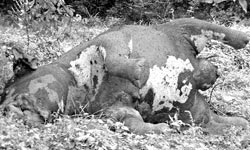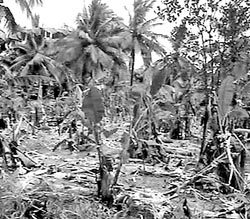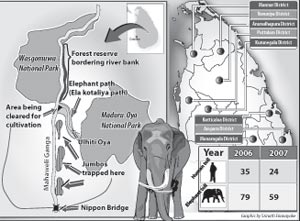
Nowhere to goEnvironmentalists trumpet warnings over agriculture farm blocking elephant corridor A private agricultural farm that is coming up in a major elephant corridor between the Wasgamuwa and Maduru Oya national parks could precipitate the human-elephant conflict in the future, environmentalists have warned. Environmentalist Samantha Suranjan said there is an important elephant pathway crossing the Nilgala, Maduru Oya, Wasgamuwa, Floodplain National Park and the Somawathiya National Park. He said this had been identified by a Mahaweli Environment Report (Tippetts Abbett McCarthy Stratton – TAMS) as an important elephant corridor, but when the national parks in the area were being demarcated, the fact had been overlooked and had not been legally designated as such. This corridor is situated along Ulhiti Oya and the controversial farm is being constructed on a land between the southern side of the mouth of Ulhiti Oya and the eastern side of the bank of the Mahaweli River.
The Department of Wildlife Conservation had previously erected an electrified fence excluding this corridor. But the farm is now coming up inside this fence and the private developers are putting up new electrified fences bordering the banks of the Mahaweli river on one side and the Ulhiti Oya on the other, he said. An environmentalist cum lawyer Jagath Gunawardena warns that apart from the looming elephant problem there have been several violations of environmental laws in the construction of the farm. As the farm is located within a one mile radius of the two protected areas, Wasgamuwa National Park and the Mahaweli Nature reserve, legally it comes under the the Fauna and Flora Ordinance and is thus under the purview of the Department of Wildlife Conservation (DWLC). Mr. Gunawardena said the DWLC should have requested the developer to conduct an Environmental Impact Assessment (EIA) – as approval for such a project is vested with them-- and the application should not have been sent to the Central Environmental Authority (CEA) as had been done in this instance. He also said the developers had not kept sufficient reservation area (a minimum distance of 100 metres) between the property, the Mahaweli River and the Ulhiti Oya, as they have put up new electrified fences along the river and the Oya. With the corridor being blocked on either side, animal movement has been impeded completely, not even allowing the movement provided by the previous fence erected by the DWLC.
“Allowing a private party to put up an electrified fence is a bad precedent, particularly as these fences are usually erected by the DWLC meeting specified standards and regulations. These wires have been strung close together, and could even endanger the lives of much smaller animals. Many villagers have also voiced their concern that the new fencing would lead to unnecessary human-elephant conflict”. Mr. Gunawardena said. He also said blocking the traditional migratory route of the elephants could affect their breeding patterns. Pointing out to more violations by the developers, Mr. Suranjan said, they were putting up a pump house along the banks of the Mahaweli as well as illegally dredging sand from the Ulhiti Oya and the Mahaweli River. Villagers complain of official apathy The ongoing human-elephant conflict appears to be taking a turn for the worse in the north-central and north-western parts of the country where thousands of villagers are being affected. With elephants straying into villages and authorities failing to look into matters of proper fencing, these villagers have taken their own precautionary measures, sometimes proving detrimental to both human life and elephants. Since last year at least 112 elephants and 50 people have been killed due to the escalating conflict and many villagers keep vigil at night for fear of attacks. Villagers who have lost house and crops, sometimes take drastic measures such as poisoning these majestic beasts in the face of official apathy. Kurunegala, Puttalam, Anuradhapura, Vavuniya and Mannar are some of the worst affected districts. In Kurunegala the worst affected areas have been identified as farming villages in the Pradeshiya divisions of Mahawa, Kobeigane and Polpithigama.
The main reasons for the escalation of the conflict have been identified as the release of large tracts of land for development projects with little heed to protecting elephant corridors and chena cultivation in protected areas. The elephants are known to wander into abandoned chena cultivations in search of food . Villagers also complain that officials have failed to maintain the electrified fences that have been erected to protect the villages. This is particularly so of the fence that separates the Kahalla Pallekele sanctuary from the boundary villages of Mahawa and Polpithigama. Rampaging elephants have destroyed more than 10 houses and cultivations of kurukkan and paddy. One of the recent victims was a 10 year old boy from the village of Kotavehera. The victim had as usual stepped out of his home to use the toilet around 6 in the morning when an elephant had appeared from nowhere and attacked him. Villagers claim that elephants released into the sanctuaries from Pinnawala and Udawalawe stray into the villages in search of food. The villages of Kobeigane, Mawathagama and Hengamuwa have faced the worst threat with 800 families in eight grama sevaka divisions being affected. The electrified fence erected in the boundary of the villages of Mawathagama and Hengamuwa is below standard and is not maintained, villagers complain. They say as a result a herd of about 13 elephants regularly roam into their villages. About 900 coconut trees and a plantain cultivation covering area of about 30 acres have also been destroyed. This has dissuaded farmers from cultivating an area of about 600 acres.
The plight of the villagers had been taken up at a recent meeting in the Kurunegala District Secretariat. The meeting had been attended by Minister of Rural Industry and Self Employment promotion S.B.Nawinna, North Western Province Chief Minister Athula Wijesinghe and Wild Life Deputy Director General Edward Wilson. Mr. Wilson claimed that it was a single rouge elephant that was responsible for most of the attacks. He said a lack of resources and finances was hampering the project to scare the elephants away. Mr. Nawinna also said they were unable to tackle the issue because of the lack of funds faced by the Wild Life Department. He said the Department didn’t appear to have any concrete measures to handle the issue. He charged that the officials in the department were indifferent and by the time they found any solution to the ongoing conflict both species, men and the elephants would be wiped out. The regions Wild Life Dept’s Asst. Director M.Amararatna said wildlife issues were overseen by the office at Galgamuwa that was manned by six officials who had also been allocated three vehicles. He said an electrified fence stretching 95 km had been constructed, but there were only three labourers to maintain the fence. Eastern elephants: Victims of war The drastic reduction of forest cover and the war situation in the east have contributed to the escalation of the conflict between elephants and villagers in this region. The elephant population here is distributed among the national parks of Galoya, Kumana and Lahugala and other sanctuaries including Senanayake Samudra, Ampara Sellakkaoya, Buddhangala and Kudumbigala.
Although the death toll on both sides — elephant and man – is increasing, wild life officials say there’s little they can do. “When the animals are forced out of their exclusive habitats, it is natural that they stray into human territory resulting in their deaths at the hands of angered men. They also suffer from electrified fences when they dare to cross into villages in search of food destroying property and cultivation. As a result both man and beast have become casualties. The war too contributed to the death of many elephants especially in Kandikurichchuaru,” a wildlife official said. According to Gamini Samarakoon, Assistant Director, WildLife Department Eastern Province for this year alone many elephants had become victims of pressure mines and shot at by homeguards when they strayed into villages. Wildlife officials said upto August this year one human death had been reported as against 14 animals. He said these elephants were victims of the resumption of the war. About 11 had died from injuries caused by automatic fire and mines. The toll was low in 2004 due to measures taken by officials to light fire crackers to scare the animals away. |
|| Front
Page | News | Editorial | Columns | Sports | Plus | Financial
Times | International | Mirror | TV
Times | Funday
Times || |
| |
Copyright
2007 Wijeya
Newspapers Ltd.Colombo. Sri Lanka. |




